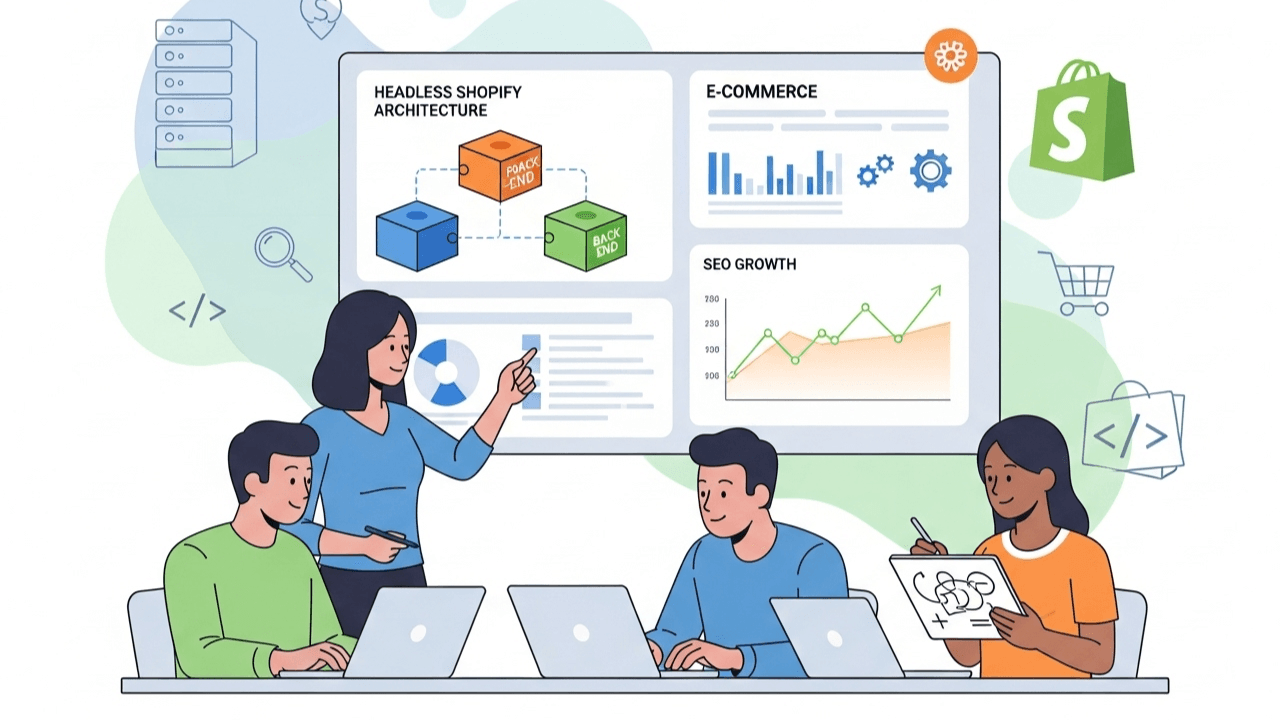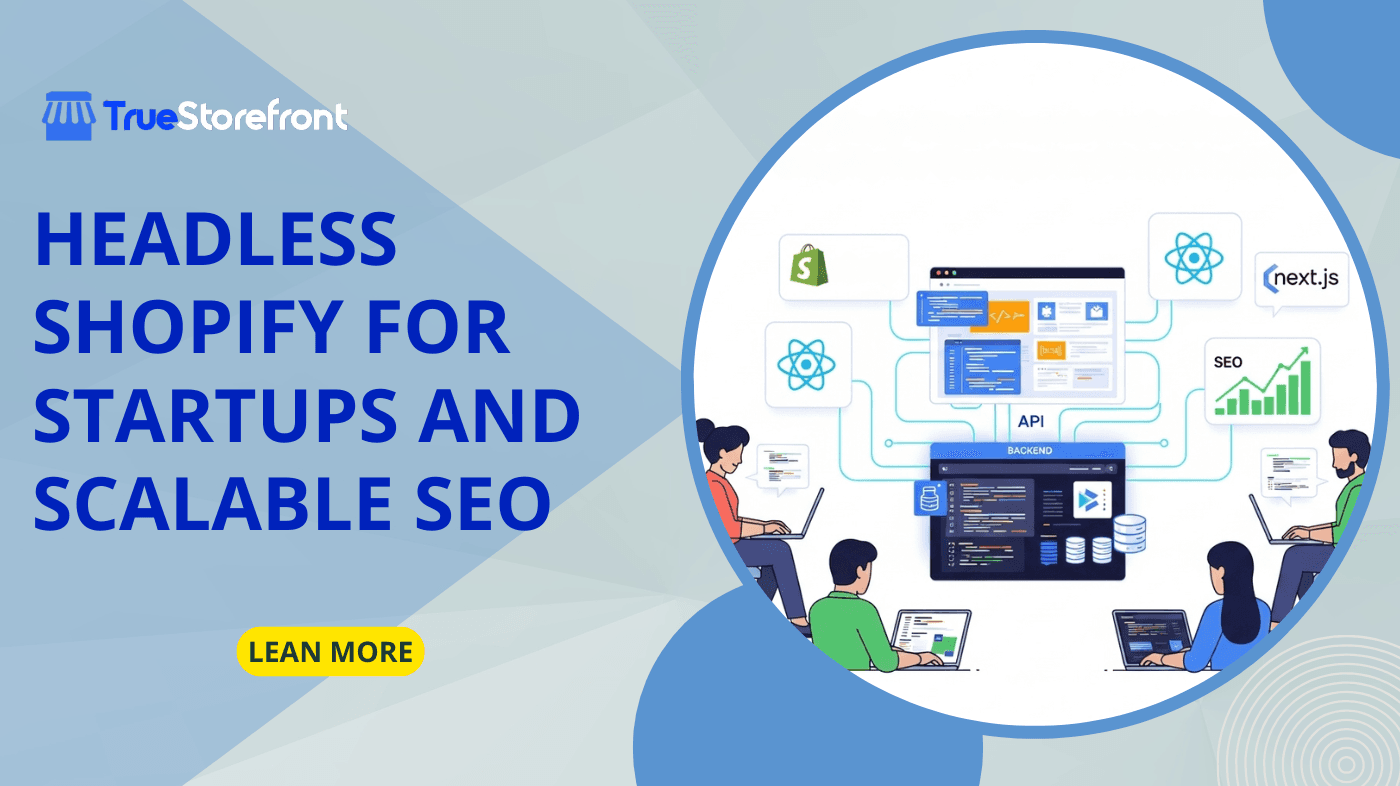In today’s digital-first world, startups entering the eCommerce market face fierce competition. Launching a store is no longer enough; standing out on search engines and delivering lightning-fast user experiences are what truly determine success. This is why many early-stage brands are turning to Headless Shopify for startups, a modern approach that separates the front end and back end of your online store to gain long-term SEO scalability and site performance advantages.
This article explores why Headless Shopify for startups is becoming the go-to solution for emerging brands seeking scalable SEO growth and sustainable online visibility.
I. The Challenge: SEO and Scalability for Startups
 Startups often face two major challenges in their eCommerce journey:
Startups often face two major challenges in their eCommerce journey:
- Building brand visibility through SEO on a limited budget
- Ensuring scalability as their online store grows
Traditional Shopify themes are efficient for quick launches but may limit customization, performance optimization, and advanced SEO strategies. Early-stage brands need flexibility to experiment, iterate, and scale without compromising their SEO foundation. That is where Headless Shopify for startups transforms the game.
II. What Is Headless Shopify?
Headless Shopify decouples the front end (what customers see) from the back end (where store data, checkout, and inventory live). This architecture allows developers to use modern frameworks such as React, Next.js, or Hydrogen to build highly customizable storefronts while keeping Shopify as the powerful eCommerce engine.
In short, it gives startups:
- Total design and performance control
- API-driven flexibility to integrate with third-party tools
- Freedom to optimize SEO independently of Shopify’s default templates
III. Why Startups Choose Headless Shopify for SEO Scalability
3.1. Faster Page Speed for Better Rankings
Speed is one of the most crucial ranking factors in Google’s algorithm. Traditional Shopify themes can become bloated with third-party apps and scripts that slow down the site. A headless architecture:
- Loads only essential content dynamically
- Uses CDNs (Content Delivery Networks) for faster global performance
- Reduces Time to First Byte (TTFB), improving Core Web Vitals which directly benefits SEO
For startups, this speed advantage means higher rankings, better engagement, and lower bounce rates.
3.2. Advanced SEO Customization
In traditional setups, SEO control is often limited to Shopify’s default structure. With Headless Shopify for startups, developers can:
- Create custom meta tags, schema markup, and canonical URLs
- Use dynamic routing to structure URLs precisely for SEO
- Integrate advanced analytics and headless CMS tools such as Sanity or Contentful to manage SEO-friendly content
This level of control enables startups to implement enterprise-grade SEO strategies from day one, even with smaller teams.
3.3. Future-Proof Architecture for Long-Term Growth

Scalability is key for startups planning to expand quickly. A headless setup allows developers to add or modify components without disrupting the store’s structure. Whether you want to integrate new marketing tools, experiment with personalized content, or expand globally, the architecture supports it seamlessly.
In other words, Headless Shopify for startups grows as your brand grows, providing a vital advantage for startups that aim to evolve without costly replatforming.
3.4. Superior Omnichannel Experience
SEO today extends beyond Google. Voice search, mobile browsing, and social commerce all influence discoverability. Headless architecture makes it easier to deliver a consistent, high-performing experience across channels, including web, app, kiosk, and wearable devices. This consistency enhances user engagement and increases brand authority, both of which are powerful indirect SEO signals.
3.5. Better Content Delivery and Personalization
For startups, content is the backbone of organic growth. A Headless setup allows seamless integration with headless CMS platforms to publish blogs, product pages, and guides optimized for SEO. Additionally, with API connections to AI-based personalization engines, startups can deliver tailored experiences that increase time-on-site and reduce bounce rates, two critical SEO performance factors.
IV. Real-World Example: How Startups Scale SEO with Headless Shopify
Imagine a startup skincare brand launching its Shopify store. Initially, they use a standard theme to go live quickly. However, as traffic grows, they face:
- Slower page load times from multiple Shopify apps
- Limitations in customizing meta tags and content structure
- Difficulty connecting dynamic blog content to product pages
After migrating to Headless Shopify for startups, the brand:
- Improves site speed by 45%
- Increases organic traffic by 60% within six months
- Expands globally with multilingual SEO support and region-based content
The result is sustainable SEO growth and a smoother user experience.
V. Comparing Headless Shopify vs. Traditional Shopify
VI. The Business Value for Early-Stage Brands
Choosing Headless Shopify for startups is not just a technical decision; it is a strategic investment in sustainable business growth. Here’s why startups see it as a game-changer:
- SEO scalability ensures your brand visibility continues expanding
- Performance optimization strengthens user trust and conversions
- Flexible integrations future-proof your store against emerging technologies
In short, Headless Shopify for startups aligns with startup agility, enabling rapid innovation while maintaining SEO integrity.
VII. When Should Startups Go Headless?
Headless may not be for every early-stage brand. However, it is ideal when:
- Your store relies heavily on content marketing and SEO
- You are targeting rapid growth or global expansion
- You need custom integrations or unique user experiences
- You have access to a developer or agency with headless expertise
Startups at this stage benefit most when they plan for long-term SEO scalability, not just a fast launch.
Final Thoughts
In the race to build visibility and credibility online, startups need a scalable SEO foundation that grows with their business. Headless Shopify for startups provides exactly that by combining Shopify’s robust backend with modern, flexible frontend technologies for unmatched performance and SEO control.
As search algorithms continue to reward speed, structure, and user experience, startups leveraging Headless Shopify for startups are setting themselves up for lasting success.
Ready to future-proof your startup’s growth? Explore Headless Shopify for startups today and scale your SEO performance with a solution built for agility, speed, and scalability.
Read more:
